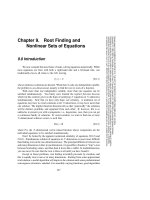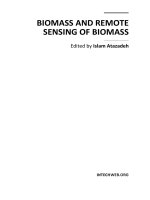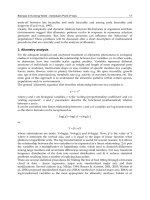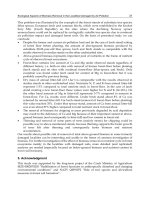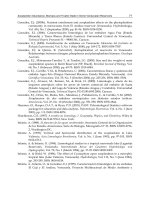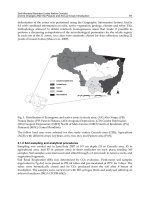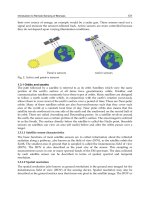Biomass and Remote Sensing of Biomass Part 1 doc
Bạn đang xem bản rút gọn của tài liệu. Xem và tải ngay bản đầy đủ của tài liệu tại đây (616.96 KB, 20 trang )
BIOMASSANDREMOTE
SENSINGOFBIOMASS
EditedbyIslamAtazadeh
Biomass and Remote Sensing of Biomass
Edited by Islam Atazadeh
Published by InTech
Janeza Trdine 9, 51000 Rijeka, Croatia
Copyright © 2011 InTech
All chapters are Open Access articles distributed under the Creative Commons
Non Commercial Share Alike Attribution 3.0 license, which permits to copy,
distribute, transmit, and adapt the work in any medium, so long as the original
work is properly cited. After this work has been published by InTech, authors
have the right to republish it, in whole or part, in any publication of which they
are the author, and to make other personal use of the work. Any republication,
referencing or personal use of the work must explicitly identify the original source.
Statements and opinions expressed in the chapters are these of the individual contributors
and not necessarily those of the editors or publisher. No responsibility is accepted
for the accuracy of information contained in the published articles. The publisher
assumes no responsibility for any damage or injury to persons or property arising out
of the use of any materials, instructions, methods or ideas contained in the book.
Publishing Process Manager Niksa Mandic
Technical Editor Teodora Smiljanic
Cover Designer Jan Hyrat
Image Copyright linerpics, 2010. Used under license from Shutterstock.com
First published August, 2011
Printed in Croatia
A free online edition of this book is available at www.intechopen.com
Additional hard copies can be obtained from
Biomass and Remote Sensing of Biomass, Edited by Islam Atazadeh
p. cm.
ISBN 978-953-307-490-0
free online editions of InTech
Books and Journals can be found at
www.intechopen.com
Contents
Preface IX
Part 1 Biomass 1
Chapter 1 Biomass in Evolving World -
Individual’s Point of View 3
Biljana Stojković
Chapter 2 Ecological Aspects of Biomass Removal
in the Localities Damaged by Air-Pollution 21
Jiří Novák, Marian Slodičák,
David Dušek and Dušan Kacálek
Chapter 3 Invasive Plant Species
and Biomass Production in Savannas 35
John K Mworia
Chapter 4 Zooplankton Abundance, Biomass and
Trophic State in Some Venezuelan Reservoirs 57
Ernesto J. González, María L. Matos,
Carlos Peñaherrera and Sandra Merayo
Chapter 5 Estimation of Above-Ground Biomass of Wetlands 75
Laimdota Truus
Chapter 6 Soil Microbial Biomass Under
Native Cerrado and Its Changes After the
Pasture and Annual Crops Introduction 87
Leidivan A. Frazão, João Luis N. Carvalho,
André M. Mazzetto, Felipe José C. Fracetto,
Karina Cenciani, Brigitte J. Feigl and Carlos C. Cerri
Chapter 7 The Above-Ground Biomass
Production and Distribution in White Willow
Community During 11 Years of Primary Succession 111
Petr Maděra, Diana Lopéz and Martin Šenfeldr
VI Contents
Part 2 Remote Sensing of Biomass 127
Chapter 8 Introduction to Remote Sensing of Biomass 129
Muhammad Aqeel Ashraf, Mohd. Jamil Maah and Ismail Yusoff
Chapter 9 Biomass of Fast-Growing Weeds in a
Tropical Lake: An Assessment of the Extent
and the Impact with Remote Sensing and GIS 171
Tasneem Abbasi, K.B Chari and S. A. Abbasi
Chapter 10 Application of Artificial Neural Network
(ANN) to Predict Soil Organic Matter Using
Remote Sensing Data in Two Ecosystems 181
Shamsollah Ayoubi, Ahmahdreza Pilehvar Shahri,
Parisa Mokhtari Karchegani and Kanwar L. Sahrawat
Part 3 Carbon Storage 197
Chapter 11 A Comparative Study of Carbon Sequestration
Potential in Aboveground Biomass in Primary
Forest and Secondary Forest, Khao Yai National Park 199
Jiranan Piyaphongkul, Nantana Gajaseni and Anuttara Na-Thalang
Chapter 12 Carbon Storage in Cold Temperate
Ecosystems in Southern Patagonia, Argentina 213
Pablo Luis Peri
Part 4 Primary Productivity 227
Chapter 13 Long-Term UVR Effects Upon Phytoplankton
Natural Communities of Patagonian Coastal Waters 229
Silvana R. Halac, Virginia E. Villafañe,
Rodrigo J. Gonçalves and E. Walter Helbling
Chapter 14 In Situ Primary Production
Measurements as an Analytical Support
to Remote Sensing - An Experimental Approach
to Standardize the
14
C Incorporation Technique 249
Tamara Cibic and Damiano Virgilio
Preface
Generally,biomass is used for all materials originating from photosynthesis. In other
words,biomassincludesallplantgrowth,herbaceousplants,microalgae,macroalgae
andaquaticplants.Butbiomasscanequallyapplytoanimalaswell.Infact,biomassis
carbonbasedandiscomposedofamixtureoforganicmoleculescontaininghy
drogen,
usually including atoms of oxygen, often nitrogen and also small quantities of other
atoms,includingalkali,alkalineearthandheavymetals.
There are various ways and methods used for evaluation of biomass. One of these
waysisremotesensing.Remotesensingprovidesinformationnotonlyaboutbiomass
but also about biodiver
sity and environmental factors estimation over a wide area.
This information includes temporal resolution and a synopsis and digital formatting
that allows for the initial processing of large amounts of data. There is a high
correlation between spectral bands and vegetation parameters. The advantages of
mostremotesensingapplicationforplantsandphytoplanktonininlandwatersaimat
the retrieval of the chloroph
yll a, as this pigment is a useful proxy for the plant
biomass. Although the pigment ratio provides an easily quantifiable approach to
monitoring,doubtshavebeenraisedaboutinterpretationoftheresults,sothemethod
should only be used as one of several methods for monitoring. The shift in pigment
ratiomaybeinfluencedbythefactthatmoreoldplantmaterialislikelytobeincluded
insamplesfromsiteswheretheorganismisstressed.
Thegreatpotentialofremotesensinghasreceivedconsiderableattentionoverthelast
few deca
des in many different areas in biological science including nutrient status
assessment, weed abundance, deforestation, glacial features in Arctic and Antarctic
regions,depthsoundingofcoastalandoceandepths,anddensitymapping.
IslamAtazadeh
ResearcherinPlantScience,
RaziUniversity,
Kermanshah,
Iran
Part 1
Biomass
1
Biomass in Evolving World
- Individual’s Point of View
Biljana Stojković
University of Belgrade
Serbia
1. Introduction
For a long time, ecology has been criticized for being primarily descriptive science
concentrated on the ‘What’ question rather than progressing further into the ‘Why’ and
‘How’ domains (O’Connor, 2000). Over the past few decades, however, ecology has moved
toward dynamic mechanistic and more strongly predictive science (Kearney et al., 2010). It
is becoming increasingly clear that to comprehend mechanisms underlying population
dynamics, demography and ecological breadth it is necessary to regard the fact that discrete
organisms, which constitute populations, might have different individual responses to
ontogenetic and environmental cues (Begon et al., 1990). The challenge is, as noted by
Kearney et al. (2010), “to derive an approach for studying penetrance of functional traits of
individual organisms into higher, group-level phenomena”.
Generally, the interdependency of population-level and individual-level processes is very
complex. Although population is composed of individuals, it has emergent properties that
are more than just the sum of the properties of individuals. Organisms come to life and die
on particular days, but populations have birth and death rates. At any specific moment,
individuals are of certain age, but populations have age structure which is very important
for determining population growth. Individual characteristics, such as size, growth pattern,
age at maturity, number of offspring and longevity, greatly influence population dynamics,
but, on the other hand, physiology and patterns of growth and development of each
organism depend both on its genotype and on population properties such as the number,
sizes and spatial distribution of other individuals. Therefore, the relationship between
organisms and their populations is reflexive; phenomena at one biological level are both the
cause and the consequence of the phenomena on other.
This chapter is dealing with individual level processes – biomass allocation strategy,
allometric growth and phenotypic plasticity. How these developmental processes may affect
population dynamics will also be discussed.
2. Individual-level phenomena
2.1 Allometry and allocation strategy
Allometry (Greek allos, “other”, and metron, “measure”; Huxley, 1932) is the study of size-
correlated variations in biological forms and processes. Niklas (1994) recognizes three
conceptual and methodological meanings of this term: 1) the growth of one part of an
Biomass and Remote Sensing of Biomass
4
organism in relation to the growth of the whole organism or some other part of it, 2) the
study of the consequences of size on organic form or process, and 3) any departure from
geometry and shape that is conserved among a series of objects differing in size. Literally,
allometry means unequal growth of organs during development of an organism. The
fundamental biological principle presumes that acquisition of external resources and
metabolism, producing energy and materials for all biological processes, enable organisms
to grow in size (i.e., enlarge biomass). However, in biological systems, increase in absolute
size always goes along with modifications in relative sizes of organismal parts. In other
words, by growing larger, individuals alter their shape; growth itself is size-dependent, i.e.
allometric (Weiner, 2004). This process is a consequence of inherent continuous changes in
directions of biomass allocation into different structures and activities during the course of
development, and reflects alterations in priorities at any point of time of individual
ontogenesis. For example, early in development, after germination and emergence of radicle
(part of a plant embryo which develops in a root), plants have more roots than shoots. Later,
as they grow, relative allocation into aboveground structures increases and results in more
‘shooty’ individuals. A late fetus has a larger head and shorter legs in relation to its body
length than an adult human. Alteration in growth pattern during human ontogeny accounts
for later changes in body part proportions. Metabolic rates and the heat produced by
metabolism increase less rapidly than total body size.
From the ecological point of view, biomass allocation strategy plays a critical role in
determining organismal ability to survive and reproduce (i.e., fitness). If an ideal organism
would exist, it would be mature at birth, continuously produce a large number of high-
quality offspring, and live forever. Such an organism, called ‘Darwinian demon’ (Law,
1979), would bedevil all other organisms. The same creature, named ‘Hutchinsonian demon’
in community ecology, would dominate in its habitat because it would be the best in
colonizing new patches, utilizing all the resources, avoiding predators and resisting stresses
(Kneitel & Chase, 2004), and, eventually, it would monopolize the life on Earth. In reality,
however, the existence of such an organism is impossible because: 1) the amount of
resources (i.e., nutrients and energy) that an organism can acquire is finite, and 2) a
proportion of the resources allocated to one activity (for example to growth, that is to
somatic maintenance and survival), decreases the amount of resources that can be allocated
to another (e.g., to reproduction). As noted by Stearns (1992), “allocation decisions between
two or more processes that compete directly with one another for limited resources within a
single individual” imply mutually exclusive allocation, or physiological trade-off.
If an increase in fitness due to a change in one trait is opposed by a decrease in fitness due to
a concomitant change in the second trait, it is clear that adaptive growth strategy in one
environment depends on optimal balance of biomass allocation between different
organismal functions (Roff & Fairbairn, 2007). Individuals must allocate resources in a way
that make the most of their chances for contributing offspring to the next generation while
simultaneously maximizing their chance of surviving to reproduce (Gurevitch et al., 2002).
Among characteristics that figure directly in reproduction and survival, and are often in
trade-off between each other, Stearns (1992) indicated several principal life-history traits:
size at birth, growth pattern, age at maturity, size at maturity, number, size and sex ratio of
offspring, age- and size-specific reproductive investments, age- and size-specific mortality
schedules, and length of life. Correlations between these traits may be positive or negative
(trade-offs), but eventually they combine in many different ways to produce diverse
schedules and durations of key events in an organism's lifetime. Logically, natural selection
Biomass in Evolving World - Individual’s Point of View
5
in one environment may prioritize some capabilities at the expense of others. As a
consequence, different life-histories evolve.
2.2.1 The evolution of life-histories
The developmental paths that describe changes in form (“ontogenetic trajectory”; Magwene,
2001) and life-history schedule are often considered to be genetically determined, i.e.,
species- or genotype-specific (Weiner, 2004), and/or the products of biomechanical and
other physical constraints (Givnish, 1986). These assertions have been brought into question
by the well documented fact that allometry itself can be plastic and trade-offs may vary with
environmental variations (e.g., Cheplick, 1995; Weiner, 2004), as well as because a significant
degree of variability in life-histories can exist within populations. However, they still can
serve as a starting point for understanding life-history evolution. Comparative biology has
demonstrated a great variety of life-histories at the level of species and higher taxonomic
groups. In plants, besides tremendous variation in life-cycle patterns, from annual
semelparous forms to long-lived iteroparous woody perennials, interesting variations can be
found in growth architecture of clonal plants with vegetative reproduction. Lovett Doust
(1981) made characterization of these clonal forms on a continuum between ‘phalanx’, in
which vegetative clones (ramets) of one parental plant are grouped tightly together, and
‘guerilla’ form, which is presented with ramets dispersed like guerilla forces. Vegetative
reproduction makes an interesting case on the diversity of life-histories. For example, in
quaking aspen (Populus tremuloides) individual trunks, which are genetically identical to
their paternal plant, live for about 50 years, while the genotype composed of many
individual plants, may live for more than 10 000 years. In animals, some species mature
early and reproduce quickly, have small body size and a large number of eggs (e.g., many
insects), whereas in other species maturation is delayed for several years, individuals are
large and have a small number of offspring (e.g., some mammals). Between these extremes,
a great variety of different combinations of life-history schedules and growth forms exists.
Although it is reasonable to presume that there is individual variability within each species,
relations between life-history traits differ substantially more between higher taxonomic
groups. Darwin elegantly explained this phenomenon – related species descended from a
common ancestor and shared common evolutionary history for a long time. These ‘lineage-
specific effects’ emphasize characteristics that are general for a group of related species or
higher taxonomic levels. The comparative analyses of species, genera, families and classes
demonstrate broad patterns of the evolution of allometry, trade-offs and life-history. The
examples of how lineage-specific mode of growth affects metabolic and growth rates, and
reproduction, can be found all over the living world. Major groups of ectothermal and
endothermal organisms have different metabolisms and different growth rates per unit
weight during growth, which is involved in determination of age at maturity and the cost of
reproduction. For ectothermal organisms, about thirty times less energy supply is needed
for the same growth rate as for endothermal (Peters, 1983). Organisms with determinate
growth (e.g., annual plants, birds, mammals, and most insects) stop growing when mature,
whereas allocation of energy between growth and reproduction continues through adult life
for organisms with indeterminate growth, such as perennial plants, fish, amphibians,
reptiles, etc. That means that ‘allocation decision’ between growth and reproduction is made
only once for the first group, and many times for the second (Stearns, 1992). The analyses of
more than 500 mammal species (Wootton, 1987) imply that body mass is positively
correlated with age at first reproduction. Age at maturity is also positively correlated with
Biomass and Remote Sensing of Biomass
6
adult lifespan within lineages of birds, mammals, some reptiles and fishes, although the
relationships between the two life-history traits differ among these large groups. If corrected
for body size, the data suggests that increase in longevity with delay of reproduction is the
highest for birds and mammals (Charnov & Berrigan, 1990).
The results of comparative analyses of higher taxonomic groups imply that changes in life-
histories are phylogenetically constrained in some degree, as a result of shared evolutionary
history, genes and developmental pathways. However, it must be kept in mind that
comparative biology provides information about boundary conditions on life-history
evolution, but, within each lineage, populations and species differ and follow their own
patterns of life-history adaptation to specific environment. Here, natural selection acts on
life-histories to adjust biomass allocation in a way that maximizes total lifetime fitness. The
genotypes (organisms) that have the ability to distribute their resources optimally for certain
ecological conditions, will reach the highest fitness and their frequencies in next generations
will rise. Those patterns of biomass allocation that present responses of populations to
natural selection, Stearns (1992) defines as microevolutionary trade-offs. The relationship
between individual-level (i.e., physiological trade-offs) and population-level (i.e.,
microevolutionary trade-offs) is inevitably complex. The physical division of limited
materials and energy supply within an organism is a boundary condition on the
evolutionary optimization of life-history strategy within a population inhabiting certain
environment. However, the ability of organisms to optimally distribute their biomass
and/or to alter the pattern of allocation in accordance with environmental change depends
on evolutionary changes of genetic variation in a population. In other words,
microevolutionary trade-offs set a trade-off structure that is a constraint for physiological
trade-offs.
Intra-individual trade-offs depend on the amount of available resources and interactions
between organisms, or in other words, they are plastic. To understand the nature of complex
and dynamic relations between different types of trade-offs, which impose both constraints
and a basis for their evolution, environmental influences on allometric patterns must be
analyzed.
2.2.1.1 Plastic allometry
It is a common knowledge that the fitness of an individual depends both on its genotype
and its environment. When live in variable abiotic and biotic circumstances, organisms may
achieve high fitness by changing their growth and life-histories so as to match the most fit
trait values for each set of environmental conditions. This property of a genotype to express
different phenotypes in distinct environments is called phenotypic plasticity, and the way
that trait expression varies across a range of environments for a given genotype is called its
norm of reaction (Bradshaw, 1965; West-Eberhard, 1989). From the allometric point of view,
plasticity can be understood as a change in allometric growth/allocation patterns in
response to the environment (Schmid & Weiner, 1993). According to the optimal allocation
theory, organisms should allocate more resources to organs that capture the most limiting
resource and less to organs that are involved in obtaining non-limiting resources. At the
same time, as was previously noted, they must optimize biomass allocation into
reproductive function in order to produce the highest possible number of quality offspring
while limiting the losses for their own survival. The solution of this incredibly complex task
depends on the characteristics of a population and physical environment. Besides variability
in genetic background of their life-history strategies, individuals within a population may
Biomass in Evolving World - Individual’s Point of View
7
also differ significantly in their ability to cope with external conditions. Different genotypes
may respond differently to the same environment, and this variability in reaction norm for
allocation patterns accounts for the total phenotypic variation. As noted by Stearns (1992),
microevolutionary trade-offs may evolve, or, in other words, population can respond to
selection, if there is genetic variation for this reaction norm (i.e., for physiological trade-offs).
Before we explore some examples of relations between life-histories and their plasticity,
several properties of phenotypic plasticity have to be explained. As a measure of change in
genotype’s trait value between different environments, plasticity need not always be
adaptive. Some alterations in individual appearance and function are merely unavoidable
consequences of organismal physiology (Sultan, 1995). Disadvantageous (maladaptive)
plasticity may results from organismal inability to maintain a constant phenotype when
faced with environmental circumstances despite fitness reduction due to variation (Alpert &
Simms, 2002). For example, in low-quality environments, or under intense competition for
resources, organisms are smaller compared with those in rich-environments; plants have
yellow leaves when deprived of sufficient nitrogen, or have lower photosynthetic rate under
low light intensity. In ecology, it is common to measure plasticity of a species as a range of
ecological conditions that a species can grow in; this measure is also called species’ niche
(Grinell, 1917). Also, it is common to assign a species as generalist or specialist. However, it
must be kept in mind that the niche of each species is determined by the sum of niches (i.e.,
reaction norms) of its members that may be plastic or nonplastic (Gurevitch, 2002). This is a
very important remark for understanding life-history evolution – we can define life-history
for each species, but its plastic responses to environmental changes give the opportunity for
further evolution of life-histories.
Plasticity of trade-offs between life history traits have been demonstrated in a large number
of studies and numerous taxa in laboratory and natural populations (e.g., Reznick, 1985;
Sinervo & DeNardo, 1996; Zuk, 1996; Tucić et al. 1997, 1998; Tucić & Stojković 2001; Roff,
2002; Stojković et al. 2009). The number of possible relations between different life-history
traits is great, and the ways in which they can change under various environmental
conditions is, logically, much greater. Here, I present just a few examples to illustrate both
the theoretical and empirical knowledge on life-history/allometry plasticity.
The allometry plasticity can be demonstrated with one of the best understood adaptive
plastic systems in plants, generally termed as the ‘shade avoidance’ syndrome (Smith &
Whitelam, 1997). Plants are able to detect low ratio of red to far-red radiation (R:FR) in
ambient light as the first signal of future competitive interactions, well before mutual
shading actually occurs (Ballaré et al., 1987, 1990). Because chlorophyll preferentially
absorbs red light, radiation transmitted through or reflected from a leaf canopy exhibits
lower R:FR ratio than does full sunlight (Smith et al., 1990). Therefore, the R:FR ratio can be
seen as an environmental, external, cue of population density. It triggers a suite of
photomorphogenic plastic responses (e.g., stem elongation, branching reduction,
acceleration of flowering) that enables plants to minimize effects of mutual shading by
neighbours and maximize the ability to deny light to proximal plants (Aarsen, 1995). The
allometric shift in plant growth form is achieved through an increased shoot extension rate
coupled with a strong apical dominance (main stem dominance). In crowded conditions this
growth pattern enables plants to acquire more radiant energy for photosynthesis and
improve their final performance. In uncrowded situations, however, elongation of stems has
more costs than benefits. More resources must be allocated into support structures rather
than to flowers and seeds. That is why elongated growth form of plants is adaptive only in
Biomass and Remote Sensing of Biomass
8
dense environment. Many experiments on plants strongly corroborated the evolutionary
ecological prediction that the shade avoidance phenotype is indeed an adaptation, likely
moulded by natural selection from competition for light (Dudley & Schmitt, 1996; Schmitt,
1997; Schwinning & Weiner, 1998; Tucić & Stojković, 2001).
In the study on perennial clonal species Lamium maculatum, Stojković et al. (2009) have
shown that genotype by environment interaction could change the proportion of biomass
allocated into reproductive function. The goal of the experiment was to analyze changes in
biomass allocation patterns across genetically structured populations where plants are
competing for access to light. Clonal replicates of 17 genotypes were grown under three
regimes: 1) control (C; low level of competition), 2) intraclonal competition (S; competition
between clones of the same genotype) and, 3) interclonal competition (M; competition
between plants of different genotypes). It was shown that the growth of these plants was
sensitive to genetic identity of competitors, and that the competition between genetically
Allometric
relationship
Test of isometry
(Ho: α = 1)
Treatment R
2
P
α F
P
logFW:
log(SW+LW+RW)
C 0.00 0.720 2.52
A
105.36 0.000
S 0.10 0.003 1.99
A
52.39 0.000
M 0.24 0.000 1.59
B
22.77 0.000
logSW:
log(FW+LW+RW)
C 0.80 0.000 1.18
A
14.02 0.000
S 0.89 0.000 1.07
A
3.37 0.070
M 0.89 0.000 0.99
B
0.04 0.841
logLW:
log(FW+SW+RW)
C 0.64 0.000 0.82
A(e)
10.92 0.001
S 0.79 0.000 0.80
B(e)
22.37 0.000
M 0.83 0.000 0.78
C(e)
33.75 0.000
logRW:
log(FW+SW+LW)
C 0.68 0.000 1.41
B(e)
37.39 0.000
S 0.75 0.000 1.54
A(e)
73.31 0.000
M 0.86 0.000 1.53
A(e)
119.84 0.000
Table 1. Standardized major axis tests of the allometric relationship (log scaled variables) for
reproductive effort (FW) and relative biomass investments to stems (SW), leaves (LW) and
roots (RW) based on weight measures of L. maculatum plants grown in three experimental
treatments (control - C, intraclonal - S and interclonal - M competition). Scaling slope α, R
2
and P values for correlations within treatments are reported. Results of pairwise slope
comparisons between treatments (based on 1000 iteration in permutation testing) are
presented as letters in superscript. If differences among slopes were insignificant, pairwise
tests of shift in elevation were performed and results presented as letters in subscript [(e)-
elevation]. Identical letters indicate insignificant difference of either slopes or elevation
between treatments. Letter A points to the largest value. F statistics and P values of the test
of differences between observed slope within treatments and α=1 are reported as statistics of
isometry testing (Stojković et al., 2009).
Biomass in Evolving World - Individual’s Point of View
9
unrelated individuals was the most stressful environment for this plant species (the indices
of competition intensity were the highest in this treatment, unpublished data). Analyses of
allometric growth (mathematical procedure of this analysis will be explained later) revealed
that in resource-rich, noncompetitive environment, where absolute fecundity is the highest,
allocation to reproduction (flower weight - FW) is less determined by the size of plants than
in competitive condition (insignificant correlation between flower weight and vegetative
weight, P = 0.720, Table 1).
On the other hand, allocation patterns into reproductive function differed considerably
between S and M treatments (Table 1). First, it was shown that relationship between weights
of vegetative and reproduction modules was anisometric (slope of allometric relation
significantly larger than 1), indicating that relative biomass allocation to reproductive effort
was greater for larger plants in competition, which achieved higher reproductive outcome.
As was shown in the analyses of two treatments with different genetic identity of
competitors, small individuals in intense competition (interclonal) tended to allocate larger
proportion of acquired resources to reproductive organs compared with small plants in less
intense competition (intraclonal). The reverse is true for larger plants suggesting that
successful, big individuals in severe asymmetric interaction can balance more productively
between vegetative and reproductive fitness components than smaller plants. This
conclusion was based on a significantly slighter allometric slope in interclonal competition
(α = 1.59, P < 0.000 for M; α = 1.99, P < 0.003 for S; Table 1, Figure 1).
Fig. 1. The allometric relationship (log scaled variables) between reproductive effort (flower
weight; FW) and allocation to vegetative modules for L. maculatum grown in three
experimental treatments (control, intraclonal and interclonal competition). The SMA
allometric function plotted through the individuals in control treatment (dashed line),
intraclonal competition (thin line) and interclonal competition (thick line). Symbols for
individuals in control (□), intraclonal (+) and interclonal (■) competition (Stojković et al.,
2009).
Biomass and Remote Sensing of Biomass
10
Allocation analyses between other plant organs (weight of flowers, stems, leaves and roots)
also suggested that in L. maculatum specific allometry strategy of smaller plants in intense
competition with unrelated individuals could reflect trade-offs in favor of reproductive
effort, both directly via allocation to flowers and indirectly into stems (i.e., to new plant
meristems which could be committed to reproductive function). Such investment to flowers
may be beneficial for smaller individuals because allocation of limited acquired biomass to
extensive vegetative growth (e.g., leaves) may leave insufficient time for successful
reproduction before the end of growing season (Bonser & Aarssen, 2001). Many studies
reported that plants grown in competitive environments invested relatively more in sexual
reproduction (e.g., Prati & Schmid 2000; Van Kleunen et al., 2002).
Phenotypic plasticity of correlations between life-history traits has been confirmed in many
insect species. In order to analyze trade-off between the size and number of eggs, Fox et al.
(1997) performed a study on seed beetle Stator limbatus. These beetles develop completely
inside seeds of over 50 different host plants, and emerge from seeds as adults. In their
experiments, Fox and colleagues reared beetles on acacia (Acacia greggii) which is a good
host, and a palo verde (Cercidium floridum) suboptimal host on which survival of larvae is
less than 50%. Several presumptions from life-history theory were made: 1) there is a trade-
off between size and number of offspring, i.e., the same amount of resources can be
allocated into large number of small offspring, or into few big ones, 2) a probability of
survival for any individual offspring is an increasing function of its size, and 3) the
minimum size for offspring survival is smaller on the good host. If these assumptions are
correct, females of S. limbatus should lay larger eggs on the poor host than on the good host.
The study confirmed this hypothesis – females adjusted the size of eggs to the host on which
they laid, and, also, these larger eggs came at cost of fewer egg produced over a lifetime.
Additionally, it was shown that the production of larger eggs was adaptive. Survival of
larvae hatching from small eggs was less than 1%, whereas 24% of the larvae hatching from
large eggs survived to adulthood on suboptimal host. On the other hand, since the majority
of larvae that developed on acacia seeds survive, higher lifetime reproductive success of
females is achieved by producing more and smaller eggs. Berrigan (1991) performed meta-
analysis of the relationship between egg size and number in three orders of insects and
found negative correlations (i.e., trade-off) among these life-history traits.
One of the most important determinants of life-history evolution is ‘age-specific selection’
(Rose, 1991; Charlesworth, 1994) which is well described through several major trade-offs:
between time schedules of reproduction and longevity, early and late fecundity,
reproduction and growth, etc. Evolutionary changes in allocation strategy between different
life-history traits have been continuously detected in laboratory evolution experiments on
Acanthoscelides obtectus (Tucić et al., 1997, 1998). The methodology of experimental evolution
is a valuable research tool for the study of basic mechanisms that shape individual life-
history because it provides opportunity for testing direct and correlated responses to
selection. In the laboratory of these researchers, seed beetle A. obtectus has been selected to
reproduce either early (E selection line) or late in life (L selection line). About 200
generations of selection for early reproduction gave rise to beetles with enhanced fitness
during early life, a short life span and small body size. On the other hand, adults of both
sexes selected for late-reproduction are bigger, live longer, and have increased late fecundity
and total fecundity compared with beetles from the E treatment. During the course of age-
specific selection on A. obtectus, at least two trade-offs were experimentally documented: the
